European jackal
| European jackal | |
|---|---|
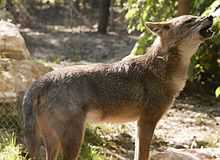 | |
| C. a. moreotica, Zoo Szeged, Hungary | |
| Scientific classification | |
| Kingdom: | Animalia |
| Phylum: | Chordata |
| Class: | Mammalia |
| Order: | Carnivora |
| Family: | Canidae |
| Genus: | Canis |
| Species: | C. aureus |
| Subspecies: | C. a. moreoticus |
| Trinomial name | |
| Canis aureus moreoticus[1] I. Geoffroy Saint-Hilaire, 1835 | |
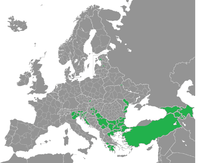 | |
| Range map | |
| Synonyms | |
|
C. a. graecus (Wagner, 1841) | |
The European jackal (Canis aureus moreoticus), also known as the Caucasian jackal[2] or reed wolf[3] is a subspecies of golden jackal native to Southeast Europe, Asia Minor and the Caucasus. Its Latin name, moreoticus, means "of Morea". It is one of the rarest and least known native canids in Europe, and is not recognized as a large carnivore by the Large Carnivore Initiative for Europe (LCIE), despite being the same size as the Iberian lynx, which is itself classed as such.[4] Though mostly found in scattered populations within Eastern Europe, its range has grown to encompass parts of its former Eastern European range, as well as in Western Europe, which is thought to be attributable to a decline in wolf populations.[4][5][6]
Physical description
It is one of the largest jackals in the world, with probably only the Egyptian jackal exceeding it in size; animals of both sexes average 120–125 cm (47–49 in) in total length and 10–13 kg (20–29 lb) in body weight.[6] One adult male in North-Eastern Italy is recorded to have reached 14.9 kg (33 lb).[7] The fur is coarse, and is generally brightly coloured with blackish tones on the back. The thighs, upper legs, ears and forehead are bright reddish chestnut.[2] Jackals in Northern Dalmatia have broader than average skulls, which is thought to result from human induced isolation from other populations, thus resulting in a new morphotype.[8]
Diet
In the Caucasus, jackals mainly hunt hares, small rodents, pheasants, partridges, ducks, coots, moorhens and passerines. They readily eat lizards, snakes, frogs, fish, molluscs and insects. During the winter period, they will kill many nutrias and waterfowl. During such times, jackals will surplus kill and cache what they do not eat. Jackals will feed on fruits such as pears, hawthorn, dogwood and the cones of Common Medlars.[2] European jackals tend not to be as damaging to livestock as wolves and red foxes are, though they can become a serious nuisance to small sized stock when in high numbers.[6] The highest number of livestock damages occurred in southern Bulgaria: 1,053 attacks on small stock, mainly sheep and lambs, were recorded between 1982–87, along with some damages to newborn deer in game farms. In Greece, rodents, insects, carrion, and fruits comprise the jackal’s diet, though they rarely eat garbage, due to large numbers of stray dogs preventing them access to places with high human density.[6] Jackals in Turkey have been known to eat the eggs of the endangered green turtle.[9] In Hungary, their most frequent prey are common voles and bank voles.[10] In Dalmatia, mammals (the majority being even-toed ungulates and lagomorphs) made up 50.3% of the golden jackal's diet, fruit seeds (14% each being common fig and common grape vine, while 4.6% are Juniperus oxycedrus) and vegetables 34.1%, insects (16% orthopteras, 12% beetles, and 3% dictyopteras) 29.5%, birds and their eggs 24.8%, artificial food 24%, and branches, leaves, and grass 24%.[11] Information on the diet of jackals in North-Eastern Italy is scant, but it is certain that they prey on small roe deer and hares.[7]
Range
Bulgaria has the largest European jackal population, which went through a 33–fold increase in range from the early sixties to mid-eighties. Factors aiding this increase include the replacement of natural forests with dense scrub, an increase in animal carcasses from state game farms, reductions in wolf populations and the abandonment of poisoning campaigns. In the early 1990s, it was estimated that up to 5000 jackals populated Bulgaria. The population increased in 1994, and appears to have stabilised.[6]
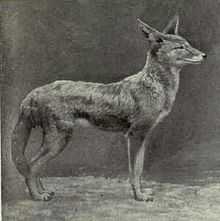
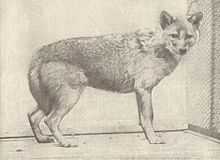
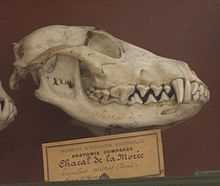
In Greece, golden jackals are the rarest of the three wild extant canids there, having disappeared from Central and Western Greece and are now limited to discontinuous, isolated population clusters in Peloponnese, Phocis, Samos Island, Halkidiki and North-eastern Greece. Currently, the largest population cluster is located in Nestos, north-eastern Greece. Although listed as "vulnerable" in the Red Data Book for Greek Vertebrates, the species has neither been officially declared as a game species nor as a protected one.[12]
The subspecies is common in the Balkan Peninsula.[4] Jackal populations have been increasing in Serbia since the late 1970s, and occur mainly in north-eastern Serbia and lower Srem. Jackals are especially common near Negotin and Bela Palanka, where during the 1990s, about 500 specimens were shot.[6] In Croatia, 19 jackal packs have been confirmed in the north-western part of Ravni kotari and two on Vir Island.[13] Golden jackals are listed as a protected species in Slovenia, where they were first spotted in 1952 and have also established permanent territories there.[14] In 2005, a probably vagrant female was accidentally shot near Gornji Grad in the Upper Savinja Valley, Northern Slovenia.[4] In 2009, two territorial groups of golden jackal were recorded in the Ljubljana Marshes area, Central Slovenia. It seems that the species continues to expand towards Central Europe.[14] Jackal populations in Albania however are on the verge of extinction with possible occurrence in only three lowland wetland locations along the Adriatic Sea.[6]
In Hungary, where they are sometimes called "reed wolves",[3] golden jackals had disappeared in the 1950s through hunting and habitat destruction, only to return in the late 70's, with the first breeding pairs being detected near the southern border in Transdanubia, then between the River Danube and Tisza. Golden jackals have increased greatly in number year by year, with some estimates indicating that they now outnumber red foxes. The sighting of a jackal near the Austrian border in the summer of 2007 indicated that they have spread throughout the country.[15][16]
In Italy the species is at present found in the wild in Friuli Venezia Giulia, Veneto and Trentino-Alto Adige/Südtirol. In the High Adriatic Hinterland, its distribution has been recently updated by Lapini et al. (2009).[17] It was hypothesized that the earliest evidence of golden jackals in Italy came from fossils found in Apulia dating back to the late Pleistocene,[18] on the basis of fossil remains found in Romanelli Cave. Such samples were discovered in layers located under the isotopic stadium MIS 5, and consequently they can be more precisely attributed to the end of the middle Pleistocene. Moreover, these materials have been recently re-determined and correctly attributed to Canis moschbachensis, a small, ancient relative to the wolf. For these reasons Canis aureus should be considered a post-glacial invader of north-eastern Italy.[7] In 1984 Canis aureus had reached the Province of Belluno, in 1985 a pack reproduced near Udine (this group was eliminated in 1987), a road-killed jackal was collected in Veneto in 1992, and their presence was then confirmed in the Province of Gorizia and in the hinterland of the Gulf of Trieste. In these cases, the specimens were usually roaming male subadults, though a family-group was discovered in Agordino in 1994.[19] A young dead female was discovered on 10 December 2009 in Carnia, indicating that the species' range has continued to expand.[5][17] Moreover, in the late summer of 2009, the species was also signalled in Trentino-Alto Adige/Südtirol, where it has surely reached the Puster Valley.[17] The Italian branch of WWF estimates that jackal numbers in Italy may be underestimated.[19] The golden jackal is a protected animal in Italy.[5][17]
A dead adult was found close to the road near Podolí (Uherské Hradiště District) in the Czech Republic, on 19 March 2006.[20]
In Turkey, Romania, the North Black Sea coast, and the Caucasus region, the status of jackals there is that they are largely unknown. There are indications of expansion of populations in Romania and north-western Black Sea coast, and reports of decline in Turkey.[6]
Golden jackals in Europe have been found as far north as Matsalu National Park in Estonia in 2013.[21]
Origins and presence in European tradition
Although present in Europe, jackals are rarely featured in European folklore or literature. Being a rare and elusive animal, the European jackal was historically often assumed to be an invasive species wherever it made its presence known: In Dalmatia, it was widely believed by the inhabitants of Korčula Island that African jackals were introduced to the island by the Republic of Venice to inflict damage on the Republic of Ragusa. When in 1929 a male jackal appeared on Premuda, the islanders believed that it was brought to the island "out of a sheer malice." An African origin for Dalmatian jackals has been proven unlikely, as their skulls bear little similarities to those of African jackals, but are similar to those of jackals in Asia Minor.[8] Sir William Jardine thought that jackals were first transported to Europe through the Muslim conquests.[22] However, the fossil record indicates that the golden jackal likely colonised the European continent from Asia during the Upper Holocene[4] or late Pleistocene.[18]
Surveys taken in the High Adriatic Hinterland indicate that the totality of people with first hand experience of jackals (hunters, game keepers and local people) regularly mistook red foxes affected by sarcoptic mange (or in a problematic state of moult) for golden jackals. The sighting of a true golden jackal however, was always referred to as a wolf, or a little wolf. This was verified both with photo-trapping sessions and with track studies, confirming previous observations on this matter. This erroneous and controversial perception of the golden jackal may be due to the fact that its presence is still not traditional, neither in Italian and Slovenian human culture, nor in hunting and game keeping traditions.[17]
References
- ↑ Wozencraft, W. C. (2005). "Order Carnivora". In Wilson, D. E.; Reeder, D. M. Mammal Species of the World (3rd ed.). Johns Hopkins University Press. p. 574. ISBN 978-0-8018-8221-0. OCLC 62265494.
- ↑ 2.0 2.1 2.2 Mammals of the Soviet Union Vol.II Part 1a, Sirenia and Carnivora (Sea cows; Wolves and Bears), V. G. Heptner and N. P. Naumov (eds.), Science Publishers, Inc. USA. 1998. ISBN 1-886106-81-9
- ↑ 3.0 3.1 Tamás TÓTH, László KRECSÁK, Eleonóra SZŰCS, Miklós HELTAI and György HUSZÁR (2009). "Records of the golden jackal (Canis aureus Linnaeus, 1758) in Hungary from 1800th until 2007, based on a literature survey" (PDF). North-Western Journal of Zoology 5 (2). pp. 386–405.
- ↑ 4.0 4.1 4.2 4.3 4.4 Krofel, Miha; Hubert Potočnik (2008). "First record of a golden jackal (Canis aureus) in the Savinja Valley (Northern Slovenia)" (PDF). Natura Sloveniae: Journal of Field Biology 10 (1). pp. 57–62. ISSN 1580-0814.
- ↑ 5.0 5.1 5.2 Clementi, Maria. Scoperto in Val Tagliamento lo sciacallo dorato (Italian)
- ↑ 6.0 6.1 6.2 6.3 6.4 6.5 6.6 6.7 "Conservation Action Plan for the golden jackal (Canis aureus) in Greece" (PDF). WWF Greece. Retrieved 2007-07-31.
- ↑ 7.0 7.1 7.2 (Italian) Lapini, L. (2003). Canis aureus (Linnaeus, 1758). In: Boitani L., Lovari S. & Vigna Taglianti A. (eds.) Fauna d’Italia. Mammalia III. Carnivora-Artiodactyla. Calderini publ., Bologna, pp. 47–58
- ↑ 8.0 8.1 Krystufek, Boris and Tvrtkovic, Nikola (1990). "Variability and identity of the jackals (Canis aureus) of Dalmatia" (PDF). Ann. Naturhist. Mus. Wien 91B: 7–25.
- ↑ Brown, L.; MacDonald, D.W. (1995). "Predation on green turtle Chelonia mydas nests by wild canids at Akyatan beach, Turkey". Biological Conservation 71: 55. doi:10.1016/0006-3207(94)00020-Q.
- ↑ Lanszki, J.; Heltai, M. (2002). "Feeding habits of golden jackal and red fox in south-western Hungary during winter and spring". Mammalian Biology – Zeitschrift für Säugetierkunde 67 (3): 129. doi:10.1078/1616-5047-00020.
- ↑ "Diet composition of the golden jackal (Canis aureus L.) on the Peljeac Peninsula, Dalmatia, Croatia". PERIODICUM BIOLOGORUM 112 (2): 219–224. March 9, 2006.
- ↑ Giannatos, Giorgos; Marinos, Yiannis; Maragou, Panagiota and Catsadorakis, Giorgos (2005). "The status of the Golden Jackal (Canis aureus L.) in Greece" (PDF). Belg. J. Zool. 135 (2): 145–149.
- ↑ Krofel, Miha (2008). "Survey of golden jackals (Canis aureus L.) in Northern Dalmatia, Croatia: preliminary results". Natura Croatica (Croatian Natural History Museum) 17 (4): 259–264. ISSN 1330-0520. Retrieved 18 January 2011.
- ↑ 14.0 14.1 Krofel, Miha (2009). "Confirmed presence of territorial groups of golden jackals (Canis aureus) in Slovenia" (PDF). Natura Sloveniae: Journal of Field Biology 11 (1) (Association for Technical Culture of Slovenia). pp. 65–68. ISSN 1580-0814. Retrieved 18 January 2011.
- ↑ Szabó L., M. Heltai , J. Lanszki, E. Szőcs (2007). "An Indigenous Predator, The Golden Jackal (Canis aureus L. 1758) Spreading Like an Invasive Species in Hungary". Bulletin of University of Agricultural Sciences and Veterinary Medicine Cluj-Napoca. Animal Science and Biotechnologies 64 (1–2).
- ↑ Szabó, László; Heltai, Miklós; Szűcs, Eleonóra; Lanszki, József; Lehoczki, Róbert (2009). "Expansion Range of the Golden Jackal in Hungary between 1997 and 2006" (PDF). Mammalia 73 (4). doi:10.1515/MAMM.2009.048.
- ↑ 17.0 17.1 17.2 17.3 17.4 Lapini L., Molinari P., Dorigo L., Are G. & Beraldo P. (2009). "Reproduction of the Golden Jackal (Canis aureus moreoticus I. Geoffroy Saint Hilaire, 1835) in Julian Pre-Alps, with new data on its range-expansion in the High-Adriatic Hinterland (Mammalia, Carnivora, Canidae)" (PDF). Boll. Mus. Civ. St. Nat. Venezia 60: 169–186.
- ↑ 18.0 18.1 Spagnesi, Mario and Marinis, Anna De Marina. Mammiferi d'Italia. Ministero dell' Ambiente e della Tutela del Territorio Direzione Conservazione della Natura, Istituto Nazionale per la Fauna Selvatica "Alessandro Ghigi
- ↑ 19.0 19.1 (Italian) Sciacallo dorato (Canis aureus). wwf.it
- ↑ Koubek P, Cerveny J (2007). "The Golden jackal (Canis aureus) – a new mammal species in the Czech Republic". Lynx 38: 103–106.
- ↑ "Golden Jackal survey in W. Estonia". http://goldenjackalaround.blogspot.com.es/''. March 31, 2013. Retrieved April 21, 2015.
- ↑ Jardine, William (1839). The naturalist's library, Volume 9, published by W.H. Lizars.
External links
| Wikimedia Commons has media related to Canis aureus moreotica. |